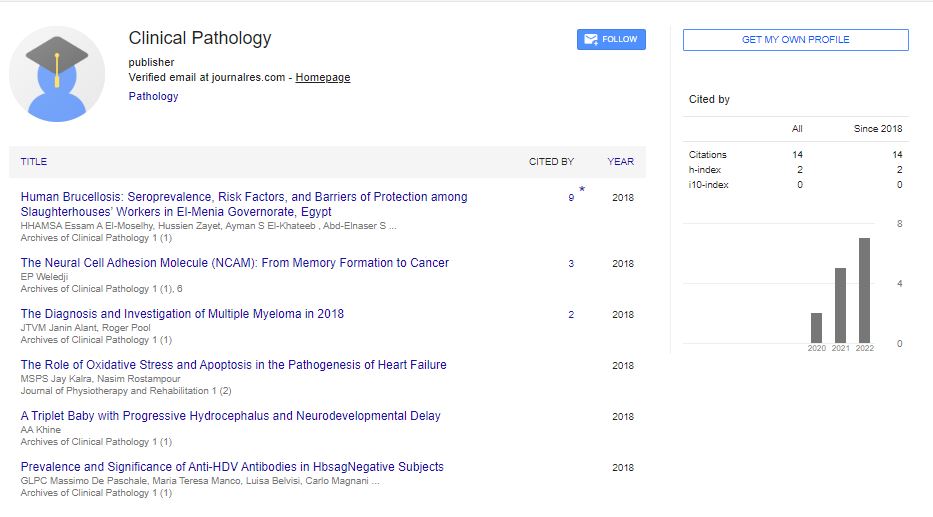Opinion Article, Arch Clin Pathol Vol: 6 Issue: 2
Exploring the Role of Anatomical Pathology in Disease Diagnosis
Pasquale Fassan*
Department of Public Health, University of Naples Federico II, Naples, Italy
*Corresponding Author: Pasquale Fassan
Department of Public Health,
University of Naples Federico II, Naples, Italy
E-mail: pasquale@fassan.uni.it
Received date: 28 May, 2023, Manuscript No. ACPY-23-107042
Editor assigned date: 31 May, 2023, Pre QC No. ACPY-23-107042 (PQ);
Reviewed date: 14 June, 2023, QC No. ACPY-23-107042
Revised date: 22 June, 2023, Manuscript No. ACPY-23-107042 (R);
Published date: 28 June, 2023, DOI: 2324-8955/acpy.05.03.100081
Citation: Fassan P (2023) Exploring the Role of Anatomical Pathology in Disease Diagnosis. Arch Clin Pathol 6:2.
Description
Anatomical pathology is a medical specialty that plays a significant role in the diagnosis of diseases by examining tissue samples, cells, and bodily fluids. It involves the study of abnormal structural and functional changes in organs and tissues to understand the underlying causes and mechanisms of diseases. Through a variety of techniques, anatomical pathologists provide essential diagnostic information that guides patient management and treatment decisions. This study discuss the role of anatomical pathology in disease diagnosis, highlighting its importance in modern healthcare.
Anatomical pathology encompasses various sub disciplines, including histopathology, cytopathology, and forensic pathology. Histopathology involves the microscopic examination of tissues to identify abnormal cellular features and patterns indicative of disease. Cytopathology focuses on the analysis of individual cells, often obtained through procedures such as fine-needle aspiration or Pap smears. Forensic pathology deals with the investigation of deaths related to criminal activities or suspicious circumstances.
Anatomical pathology plays a pivotal role in disease diagnosis by providing dire information about the nature, extent, and progression of diseases. It helps healthcare professionals accurately identify and classify various conditions, from infectious diseases to cancer. Pathologists carefully analyze tissue samples and cellular specimens to identify characteristic features, patterns, and abnormalities associated with specific diseases. This diagnostic information is essential for proper patient management and the development of appropriate treatment strategies.
Anatomical pathologists employ a range of techniques to examine tissues and cells. Microscopic examination of stained tissue sections is a fundamental method used in histopathology to visualize cellular structures and identify disease-specific changes.
Immunohistochemistry is another valuable tool that utilizes antibodies to detect specific proteins or molecular markers associated with certain diseases. Molecular pathology techniques, such as Polymerase Chain Reaction (PCR) and Fluorescence In Situ Hybridization (FISH), allow the detection of genetic and chromosomal abnormalities.
Anatomical pathology contributes to the diagnosis of various diseases across different organ systems. In oncology, it plays a central role in the identification and staging of cancers, providing information about tumor type, grade, and extent of spread. Anatomical pathology is also essential in diagnosing infectious diseases, autoimmune disorders, neurological conditions, and genetic abnormalities. By examining tissue samples, pathologists can differentiate between benign and malignant lesions, identify prognostic factors, and predict treatment responses.
Autopsies, both clinical and forensic, are dire components of anatomical pathology. Clinical autopsies help determine the cause of death, evaluate the effectiveness of treatments, and contribute to medical knowledge by identifying underlying diseases. Forensic pathology involves investigating deaths resulting from criminal activities, accidents, or unexplained circumstances. Forensic pathologists collect and analyze evidence, perform postmortem examinations, and provide expert testimony in legal proceedings.
Digital pathology has revolutionized the field of anatomical pathology by allowing the digitization and remote viewing of tissue slides. Through digital pathology systems, pathologists can access and analyze high-resolution images, facilitating collaboration, consultation, and second opinions. Telepathology enables the sharing of images and diagnostic information between pathologists in different locations, promoting timely and efficient diagnosis.
Technological advancements continue to enhance the capabilities of anatomical pathology. Automation and Artificial Intelligence (AI) are being integrated into image analysis algorithms, aiding in the identification and quantification of pathological features. Whole-slide imaging, multiplex immunohistochemistry, and next-generation sequencing are expanding the diagnostic repertoire and improving the accuracy and efficiency of disease diagnosis.
Anatomical pathology plays a significant role in disease diagnosis by providing essential information about the nature, extent, and progression of diseases. Through the examination of tissues, cells, and bodily fluids, anatomical pathologists contribute to the accurate classification, staging, and treatment of various conditions. Their expertise and diagnostic insights guide healthcare professionals in developing tailored patient management strategies. As technology advances, anatomical pathology continues to evolve, enabling precise and personalized healthcare for patients worldwide.
 Spanish
Spanish  Chinese
Chinese  Russian
Russian  German
German  French
French  Japanese
Japanese  Portuguese
Portuguese  Hindi
Hindi 